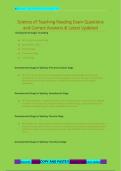1|Page: 2024/2025 Grade A+
Science of Teaching Reading Exam Questions
and Correct Answers & Latest Updated
Developmental Stages of Spelling
o :## Precommunicative Stage
o Semiphonetic Stage
o Phonetic Stage
o Transitional Stage
o Correct Stage
Developmental Stages of Spelling: Precommunicative Stage
o :## The child uses letters from the alphabet but shows no knowledge of letter sound
correspondences. the child may also lack knowledge of the entire alphabet, the distinction
between upper and lower case letters, and the left to right direction of the English
orthography.
Developmental Stages of Spelling: Semiphonetic Stage
o :## The child begins to understand letter sound correspondence-- that sounds are assigned
to letters. At this stage, the child often employs rudimentary logic, using single letters, for
example, to represent words, sounds and syllables. (U for you)
Developmental Stages of Spelling: Phonetic Stage
o :## Children use a letter or group of letters to represent every speech sound that they hear in
a word. Although some of their choices do not conform to conventional English spelling, their
attempts to spell words are systematic and easily understood (the letters tak for take and en
for in)
Developmental Stages of Spelling: Transitional Stage
Master01: DO NOT COPY AND PASTE!! August 25, 2024 Latest Update
,2|Page: 2024/2025 Grade A+
o :## The speller begins to assimilate the conventional alternative for representing sounds,
moving from a dependence only or mainly on phonology (sound) for representing words, to
evidencing a greater understanding of common letter patterns words and the structure of
words. Some examples of misspelling typical of this stage are egul for eagle, and higheked for
hiked.
Developmental Stages of Spelling: Correct Stage
o :## At this stage, spellers know common letter sound relationships and generalizations (rules)
for spelling, as well as how to use morphemic information in spelling. The student
understands how to spell many common prefixes and suffixes, silent consonants, alternative
spellings, and irregular spellings. A large number of learned words are accumulated, and the
speller recognizes incorrect forms.
Brian writes "hom" for the word home. When considering the developmental stages of
spelling, Brian uses---
o :## Phonetic Spelling
In phonetic spelling, students use their knowledge of letters and graphemes and in this
example, Brian has used a letter for every sound heard in home.
Suzie writes "spcl" for the word special. When considering the Developmental Stages of
Spelling, Suzie uses--
o :## Semiphonetic Spelling
She uses some knowledge of letter sounds relationships but does not use vowels in this
example.
Master01: DO NOT COPY AND PASTE!! August 25, 2024 Latest Update
,3|Page: 2024/2025 Grade A+
Which of the following are examples of informal assessments that prekindergarten teachers
can use?
-Progress monitoring measures
-diagnostic assessments
-ongoing observations
-systematic observations
-portfolios
o :## -ongoing observations
-systematic observations
-portfolios
-ongoing observations- teachers observe their students work and play in a variety of
settings.
-systematic observations- teachers choose specific children to observe for specific purposes
for a specific timeframe.
-portfolios- teachers collect and date authentic work samples over time. Portfolios provide a
powerful overview of a child's development and serve to guide instructional decisions.
A recent study concludes which of the following regarding dyslexia and the size of the
population it affects in the US? (looking for a %)
Master01: DO NOT COPY AND PASTE!! August 25, 2024 Latest Update
, 4|Page: 2024/2025 Grade A+
o :## Dyslexia affects 15-20% of the population in America.
Best methods for teaching Dyslexia (List)
o :## -Multisensory
-Structured, Systematic, Sequential, and Cumulative
-Flexible
-Personal and Direct
Best methods for teaching Dyslexia: Multisensory
o :## Involve regular interaction between the teacher and the students and the simultaneous
use of simple senses including auditory, visual and kinesthetic. A dyslexic learner is taught to
tee the letter A, say its name and sound and write it in the air- all at the same time. The use of
multisensory input is thought to enhance memory storage and retrieval.
Best methods for teaching Dyslexia: Structured, Systematic, Sequential and Cumulative
o :## Language elements and rules are introduced in a linguistically logical, understandable
order. Students go back to the very beginning of their language learning, to lay a proper
foundation. Beginning by reading and writing sounds in isolation (phonemes), then blending
sounds into syllables and words. Elements of language- consonants, vowels, digraph blends,
and diphthongs are introduced in an orderly fashion. Only later, learners proceed to advanced
structural elements such as syllable types, roots, prefixes and suffixes.
Best methods for teaching Dyslexia: Flexible
o :## Teachers ensure the learner is not simply recognizing a patterns and applying it without
understanding. When confusion of a previously taught rule is discovered, it is re-taught from
the beginning.
Best methods for teaching Dyslexia: Personal and Direct
Master01: DO NOT COPY AND PASTE!! August 25, 2024 Latest Update




